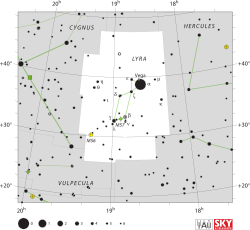|
| Delta1 Lyrae (δ1)[1] |  | Observationsdata
Epok: J2000.0 |
|---|
| Stjärnbild | Lyran |
|---|
| Rektascension | 18t 53m 43,55911s[2] |
|---|
| Deklination | 36° 58′ 18,1920″[2] |
|---|
Skenbar magnitud ( ) ) | 5,56[3] |
|---|
| Stjärntyp |
|---|
| Spektraltyp | B2.5 V[4][5] |
|---|
| U–B | -0,67[3] |
|---|
| B–V | -0,15[3] |
|---|
| Astrometri |
|---|
Radialhastighet ( ) ) | -25,8[6] km/s |
|---|
| Egenrörelse (µ) | RA: +0,78[2] mas/år
Dek.: -3,09[2] mas/år |
|---|
Parallax ( ) ) | 3,29 ± 0,25[2] |
|---|
| Avstånd | 990 ± 80 lå (300 ± 20 pc) |
|---|
Absolut magnitud ( ) ) | -1,55[7] |
|---|
| Detaljer |
|---|
| Massa | 7,9 ± 0,1[5] M☉ |
|---|
| Radie | 4,44[8] R☉ |
|---|
| Luminositet | 838[7] L☉ |
|---|
| Temperatur | 20 350[9] K |
|---|
| Metallicitet | -0,05[7] |
|---|
| Vinkelhastighet | 110[10] km/s |
|---|
| Ålder | 21,2 ± 2,2[5] miljoner år |
|---|
| Andra beteckningar |
|---|
| Delta1 Lyrae, 11 Lyrae, BD+36°3307, HD 175426, HIP 92728, HR 7131, SAO 67537, GC 25934, GSC 02650-02146, IDS 18502+3650 |
Delta1 Lyrae (ζ1 Lyrae, förkortat Delta1 Lyr, ζ1 Lyr) som är stjärnans Bayerbeteckning, är en dubbelstjärna belägen i den mellersta delen av stjärnbilden Lyran. Den har en skenbar magnitud på 5,56[3] och är svagt synlig för blotta ögat där ljusföroreningar ej förekommer. Baserat på parallaxmätning inom Hipparcosuppdraget på ca 3,3 mas,[2] beräknas den befinna sig på ett avstånd av ca 990 ljusår (300 parsek) från solen.
Egenskaper
Primärstjärnan Delta1 Lyrae A är en blå till vit stjärna i huvudserien av spektralklass B2.5 V.[4] Den har en massa som är ca 8[5] gånger större än solens, en radie som är ca 4,4 gånger större än solens radie[8] och utsänder från dess fotosfär ca 840[7] gånger mer energi än solen vid en effektiv temperatur på ca 20 400[9] K.
Delta1 Lyrae är en spektroskopisk dubbelstjärna vilket betyder att separationen mellan stjärnorna är mycket liten och deras omloppshastighet är mycket hög med en omloppsperiod av ca 88 dygn.[1][11]
Källor
- Den här artikeln är helt eller delvis baserad på material från engelskspråkiga Wikipedia, tidigare version.
Referenser
- ^ [a b] "* del01 Lyr". SIMBAD. Centre de données astronomiques de Strasbourg. Hämtad 15 oktober 2007.
- ^ [a b c d e f] e van Leeuwen, F. (2007), "Validation of the new Hipparcos reduction", Astronomy and Astrophysics, 474 (2): 653–664, arXiv:0708.1752, Bibcode:2007A&A...474..653V, doi:10.1051/0004-6361:20078357.
- ^ [a b c d] Guetter, H. H. (October 1974), "UBV photometry of 180 early-type stars", Publications of the Astronomical Society of the Pacific, 86: 795–797, Bibcode:1974PASP...86..795G, doi:10.1086/129675.
- ^ [a b] Guetter, Harry H. (April 1968), "Spectral classification of 239 early-type stars", Publications of the Astronomical Society of the Pacific, 80 (473): 197, Bibcode:1968PASP...80..197G, doi:10.1086/128611.
- ^ [a b c d] Tetzlaff, N.; et al. (January 2011), "A catalogue of young runaway Hipparcos stars within 3 kpc from the Sun", Monthly Notices of the Royal Astronomical Society, 410 (1): 190–200, arXiv:1007.4883, Bibcode:2011MNRAS.410..190T, doi:10.1111/j.1365-2966.2010.17434.x.
- ^ Wilson, Ralph Elmer (1953), General catalogue of stellar radial velocities, Carnegie Institution of Washington, Bibcode:1953GCRV..C......0W.
- ^ [a b c d] Anderson, E.; Francis, Ch. (2012), "XHIP: An extended hipparcos compilation", Astronomy Letters, 38 (5): 331, arXiv:1108.4971, Bibcode:2012AstL...38..331A, doi:10.1134/S1063773712050015.
- ^ [a b] https://www.universeguide.com/star/delta1lyrae. Hämtad 2019-03-05.
- ^ [a b] Hohle, M. M.; et al. (April 2010), "Masses and luminosities of O- and B-type stars and red supergiants", Astronomische Nachrichten, 331 (4): 349, arXiv:1003.2335, Bibcode:2010AN....331..349H, doi:10.1002/asna.200911355.
- ^ Abt, Helmut A.; et al. (2002), "Rotational Velocities of B Stars", The Astrophysical Journal, 573: 359, Bibcode:2002ApJ...573..359A, doi:10.1086/340590.
- ^ Richardson, E. H.; McKellar, A. (1957). "Redetermination of the spectrographic orbit of delta1 Lyrae". Publ. Dominion Astrophys. Obs. 10: 407–413. Bibcode:1958PDAO...10..407R. , p. 412
Externa länkar
|





